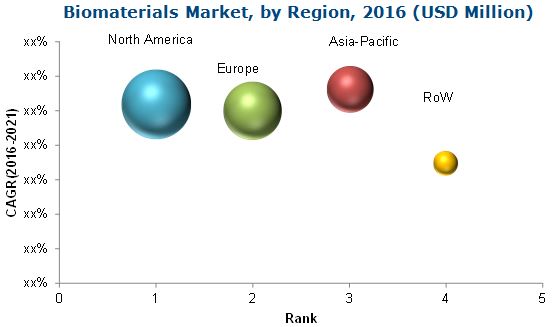According to the new market research report “Biomaterials
Market by Type of
Materials (Metallic, Ceramic, Polymers, Natural) & Application
(Cardiovascular, Orthopedic, Dental, Plastic Surgery, Wound Healing, Neurology,
Tissue Engineering, Ophthalmology) - Global Forecast to 2021”, published
by MarketsandMarkets™, analyzes and studies the
major market drivers, restraints/challenges, and opportunities in North
America, Europe, Asia-Pacific, and the Rest of the world (RoW).
The biomaterials market is projected to reach USD 149.17 Billion
by 2021 from an estimated USD 70.90 Billion in 2016, at a CAGR of 16.0%. The
growth of the overall market can be attributed to increased funds & grants
by government bodies worldwide, the growing implantable devices market,
technological advancements, rising number of hip and knee replacement
procedures, and high growth in geriatric population coupled with growing
incidence of cardiovascular diseases.
The global biomaterials market is segmented based on type of material, application, and region. Based on type of material, the global market is segmented into metallic, ceramic, polymeric, and natural biomaterials. In 2016, the metallic biomaterials segment is expected to account for the largest share of the market. The metallic biomaterials segment is further divided into stainless steel, titanium & titanium alloys, cobalt- chrome alloys, gold, silver, and magnesium. In 2016, the stainless-steel segment is projected to account for the largest share of the metallic market. The titanium and titanium alloys segment is expected to grow at the highest CAGR during the forecast period. The polymeric biomaterials segment is projected to grow at the highest CAGR during the forecast period. Polymeric biomaterials are further segmented into polymethylmethacrylate (PMMA), polyethylene, polyester, polyvinyl chloride, silicone rubber, nylon, polyetheretherketone (PEEK), PLA, PGA, and PLGA, and other polymeric biomaterials. The PMMA segment is expected to grow at the highest CAGR during the forecast period.
Browse and
in-depth TOC on "Biomaterials Market "
170 – Tables
66 – Figures
170 – Tables
66 – Figures
263 - Pages
View more detailed TOC @ https://www.marketsandmarkets.com/Market-Reports/biomaterials-393.html
View more detailed TOC @ https://www.marketsandmarkets.com/Market-Reports/biomaterials-393.html
On the basis of application, the biomaterials market is segmented
into cardiovascular, orthopedic, ophthalmology, dental, plastic surgery, wound
healing, tissue engineering, neurological/central nervous system, and other
applications. In 2016, the cardiovascular segment is expected to account for
the largest share of the biomaterials market. The plastic surgery and wound
healing segments are expected to grow at highest CAGRs during the forecast
period.
The biomaterials market is segmented into four major regions,
namely, North America, Europe, Asia-Pacific, and the Rest of the World (RoW).
Among these regional segments, North America is expected to account for the
largest share of the global market, in 2016. However, the Asia-Pacific region
is expected to grow at the highest CAGR during the forecast period. The high
growth in this regional segment can be attributed to the rising aging
population and increasing incidence of cardiovascular and orthopedic diseases
in India and China.
In the coming years, the market is
expected to witness the highest growth in the Asia-Pacific region. This can be
attributed to factors such as rising cosmetic and plastic surgeries in India,
lucrative medical device industry and new tax policy in China, growing number
of cardiovascular diseases, increasing aging population, and rising volume of
hip and knee replacement procedures in this region.
North America is expected to
account for the largest share of the global market, in 2016. Rising
biomaterial-based research, increasing demand for plastic surgeries, increasing
conferences on biomaterials, growing cancer incidence, and the rising
prevalence of cardiovascular diseases are expected to drive market growth in
this region.
Key
Players:
Some major players in the global biomaterials market include Royal DSM (Netherlands), BASF SE (Germany), Corbion N.V. (Netherlands), Covestro (Germany), Invibio Ltd. (U.K.), Carpenter Technology Corporation (U.S.), Evonik Industries AG (Germany), Berkeley Advanced Biomaterials, Inc. (U.S.), CAM Bioceramics BV (Netherlands), and Celanese Corporation (U.S.).
Some major players in the global biomaterials market include Royal DSM (Netherlands), BASF SE (Germany), Corbion N.V. (Netherlands), Covestro (Germany), Invibio Ltd. (U.K.), Carpenter Technology Corporation (U.S.), Evonik Industries AG (Germany), Berkeley Advanced Biomaterials, Inc. (U.S.), CAM Bioceramics BV (Netherlands), and Celanese Corporation (U.S.).
Click for Adjacent Markets Report Available
- Request for bundle reports: https://www.marketsandmarkets.com/RequestBundleReport.asp?id=393

Comments
Post a Comment